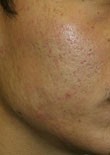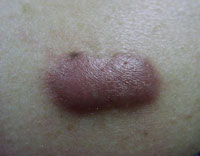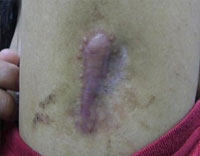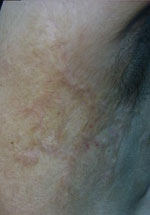About Scar
Scars form at the site of an injury to the skin tissue. This is a result of an inflammation response of the body trying to fix the injury. This is a very complex reaction involving many different chemicals and elements, and because of this, the job is not always done right. Sometimes the repair is not done enough with a lack of tissue and appearance of depression; sometimes the healing is over-done with the formation of a raised scar. So scars do come in all shapes and sizes, depending on the wound nature, age, location, nutrition, genetics or infection.
Not all scars are the result of injury. Any skin diseases with an inflammation response may cause the same problem of scarring. For example, acne can cause a variety of scars, chicken pox usually leaves an atrophic scar, and stretch marks are a form of scars caused by excessive stretching. A scar usually takes 12 to 18 months to mature.
There is considerable variation in scarring between one person and another, indicating that some people are more prone to scarring. In the case of keloids, there is a familial tendency.
Acne Scar
This is an inflammatory response to the sebum, bacteria and dead cells inside the blocked follicles. The nodulo-cystic type acne that occurs deep in the skin is most likely to result in scars, although more superficial lesions can do the same.
The presence of acne scars is very distressing psychologically, particularly in young people who are just starting a relationship or a career. It is therefore very important to prevent this by effective treatment of acne in the early stages. Treating acne scars is far more expensive and time-consuming than treating acne itself.
Acne scars can be seen as shallow depressions like the shape of a saucer plate, or as deep holes with sharp margin described as ice-pick scars. In the predisposed individuals, it can appear as raised lumps called keloids or hypertrophic scars, which are the most distressing and difficult to treat. There are few other descriptions of acne scars but they are not too useful to know.
 |
 |
There are many different treatments available for acne scars. What treatment to choose depends on the severity of scarring, the cost, the life-style and the expectation from treatment, and is best arrived after discussion with the physician.
Be realistic. Total restoration of the skin to the way it looked before the acne stared is often not possible, although some dramatic improvement of the appearance of your skin can be achieved in many cases.
The treatments for depressed scars available include:
- Collagen or fat injection to stretch and fill out some depressed but soft scars. It only lasts for a few months.
- Dermabrasion uses a high-speed brush to sand away the top layers of skin and can be used to lighten deep scars, and superficial scars may be removed completely.
- Microdermabrasion is a mild form of sanding using aluminum oxide crystals passing through a vacuum tube.
- Chemical peelings using different strengths of acids to corrode away the top layers of skin.
- Different types of ablative or non-ablative lasers, to remove the top surface and / or stimulate the underlying collagen regeneration.
- Skin surgeries, like punching out the ice-pick scars, or by grafting a new piece of skin altogether.
Atrophic Scar
Atrophic scars are depressions causing a hole in the skin, usually with a sharp margin. They are due to collagen destruction during the process of an inflammatory skin disease. Common causes include acne and chicken pox. Linear suture scars can also become atrophic and appear wide and wrinkly with a hollow feeling in the scar itself.
 |
 |
They can be treated with dermadrasion, micro-dermabrasion, and ablative laser treatments. The goal of treatment is to soften depressions and stimulate new collagen synthesis to fill in the residual defects. The lasers used include CO2 laser or a modulated erbium-YAG laser. Those non-ablative types lasers do not produce the degree of improvement equal that of ablative lasers.
Keloid Scars & Hypertrophic Scars
Both are the result of overzealous collagen synthesis together with limited collagen lysis during the remodeling phase of wound healing.
Hypertrophic scars are thickened, firm, but only slightly raised. They only lie within the boundary of injury without extending into adjacent normal tissue, and may regress with time.
Keloids are actually benign tumours of scar tissue. They continue to grow beyond the boundary of an original injury, sometimes can be extensive and many times the size of the original wound. They are raised, reddish-purple in colour and are firmer than hypertrophic scars.
 |
 |
Keloids have a genetic component and run in the family. It is more common in darker skin people than people with lighter skin. Some areas such as the chest, knees and elbows are more likely to develop keloids.
Significant improvement in hypertrophic scars is possible with the 585nm pulsed dye laser. Keloids usually require the simultaneous injection of Triamcinolone, a steroid that inhibits production of the collagen that makes up scar tissue, reduces inflammation, and helps a scar to regress.
Burn Scar
Burns injuries can be caused by heat, electricity, chemicals, or radiation. The severity of a burn depends on the heat level and the time involved, as well as the location of burn because of the variation in thickness, water content and amount of subcutaneous fat in different skin area.
A superficial burn will lose the epidermis only and the healing does not cause much problem, although post-inflammatory hyper-pigmentation may set in and last for a few months. Deeper and larger burn involving the deep dermis will result in a scar with a mixture of hypertrophic / keloid scar, contracture, and atrophic scar.

Primary treatment of the burn wound should aim to diminish scar contracture by grafting the wound as soon as possible. Early treatment of a burn scar includes use of antibiotics, fatty ointments, bandages, silicon gel sheets, and pressure garments. These aim to prevent the above scar abnormalities.
Later treatment will involve scar removal, coupled with skin grafting, skin flap, and tissue expansion, sometimes in multiple sessions. External preparation containing glycolic acid, tretinoin, and vitamin C may give certain degree of cosmetic improvement.
Contracture Scar
Contracture scar usually results from a burn injury. The edges of skin are pulled together, and the underlying layers are replaced by inelastic fibrous tissue, affecting adjacent muscles and tendons. This permanent tightening restricts normal movement of the affected area.
This is usually treated with scar removal surgery, with a skin graft or a flap procedure performed, and tissue expansion, sometimes in multiple sessions. The surgical procedures may vary according to the localization, extent and shape of the scar. This relies on the skills of a plastic surgeon specializing in burn injuries.

